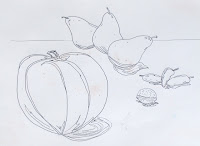 You don’t read or hear much about this in art books or on artist’s websites. Maybe that’s because artists and painters don’t want
to discuss it.
You don’t read or hear much about this in art books or on artist’s websites. Maybe that’s because artists and painters don’t want
to discuss it.
What I’m talking about is how painters draw their subject or
motif before they begin to paint. Almost always a drawing or sketch is rendered
on canvas or paper before any brushstroke is applied. Of course there are some loose
painters in watercolor who tell you not to begin with a drawing or sketch. They
say to begin your painting just use your eyeballs and the paintbrush to draw the
subject as you paint, but they seem to be in the minority.
Almost every text or website on painting says you first begin with
a drawing. But I’ve noticed there is very little discussion on how
you should render this. Often it seems the artist simply says something like, “First
I drew my subject, then I applied the first wash,” or “Begin by transferring
your drawing to the paper (or canvas).” OK. But how?
Some painters are good sketchers, some are not. I’m sure
most painters would like to be experts at both drawing and painting. In a perfect
world of artists that would be so.
Even for those en plein air painters, a simple sketch of
what is before your eyes seems to be required, so for those painting out-of-studio I suppose being able to draw well is somewhat of a must.
However, drawing and painting are two allied skills, I think.
Ideally one would be good at both, but they are not dependent upon each other.
That is, you can be a good painter and a rather poor sketcher or a good
sketcher and a poor painter. They have overlapping as well as exclusive
properties; picture a Venn diagram.
This is where the “T” word comes in. “T” stands for Trace.
It’s anathema to purists, but I bet it’s more common than you may think.
There are lots of ways to trace. You can enlarge a photo and
trace your subject on tissue paper; then apply graphite on the back, turn it
right-side up and re-trace the lines on your paper or canvas. You can use Saral
paper like carbon paper under an enlarged photo to trace the motif. Or you can use
an opaque projector to enlarge and cast an image of your subject on paper or
canvas.
All legitimate except in the eyes of purists. My guess is
that many painters trace their subjects. They’d much prefer to spend their time
painting rather than fiddling with a sketch. I can draw free-hand pretty well,
but I still have trouble with perspective and the proper proportion of objects
in the foreground versus the mid- or background, so I will trace when I need to.
I will say that almost every painting instructor tells you your
drawing must be “correct” or you’re in big trouble from the start.
As to my point on why tracing isn’t discussed much, I suppose it’s
pride along with a pinch of prejudice.
Keep On Painting
No comments:
Post a Comment